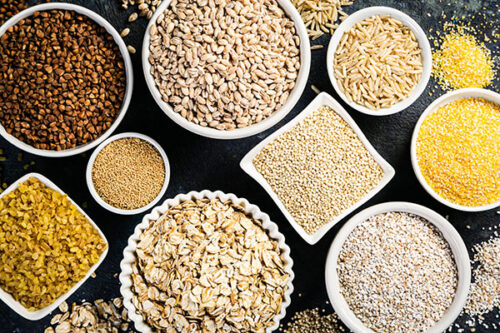Favorite 5 Articles from the April 2005 Newsletter
My Favorite 5 Articles Found in Recent Medical Journals
Dairy for Weight Loss – Another Big Fat Lie
Dairy products do not lead to alterations in body weight or fat mass in young women in a 1-y intervention by Carolyn Gunther, funded by the National Dairy Council, in the April 2005 issue of the American Journal of Clinical Nutrition found that the addition of extra dairy foods to reach a calcium intake of over 1000 mg daily resulted in an average weight gain for 135 young healthy women. The ‘medium-dairy group’ gained 0.7 of a Kg (1.5 pounds) and the ‘high-dairy group’ gained 1.5 Kg (3.3 pounds) over the course of one year. The participants were encouraged to add non-fat and low-fat milk to their diets in order to replace other foods.
The final conclusion of the authors working for the dairy industry was: ‘Results from this study show that dairy products do not promote gains in body weight or fat mass in young, healthy women. Therefore, public health recommendations can encourage young women to increase consumption of calcium through dairy products for increased bone mass, without the threat of weight gain.’
COMMENT:
The National Dairy Council has a new campaign, ‘Healthy Weight with Dairy.’ They tell you, ‘Watching your weight? Look to the fridge.’ This is grossly irresponsible advertising to a gullible public, telling them that they will lose weight by consuming more dairy products. How did a food naturally designed to grow a cow from 60 pounds to 600 pounds become the weight loss miracle for the 21st century? The dairy industry does not limit their marketing efforts to low-fat products – the consumers are led to believe that cheese, ice cream, and whole milk can be included in their weight loss programs.
The dairy industry is lying to the public and getting away with it, even though the scientific research they pay for proves their dishonesty. Information on weight gain from dairy products was presented at the ‘Dairy Product Components and Weight Regulation’ seminar given at the 2002 Experimental Biology meeting (sponsored by the dairy industry) on April 21, 2002, in New Orleans, LA. Dr. Susan Barr wrote in a follow up article to material she presented at this meeting, ‘Nine studies of dairy product supplementation were located: In seven, no significant differences in the change in body weight or composition were detected between treatment and control groups. However, two studies conducted in older adults observed significantly greater weight gain in the dairy product groups. (These two studies used low-fat dairy products.) She summarizes, ‘In conclusion, the data available from randomized trials of dairy product or calcium supplementation provide little support for an effect in reducing body weight or fat mass.’
In this latest study by Gunther, clearly showing weight gain with low-fat dairy, they try to ‘make lemonade out of sour lemons’ by putting a positive spin on the results – concluding that young women can add ‘bone mass, without the threat of weight gain.’
Even though the dairy industry spends more than $166 million annually to try to convince you that cow’s milk is ‘health food,’ the truth will never change: Dairy is the most serious food danger facing men, women and children in developed countries. For a detailed discussion on dairy products, please read from my newsletter archives my April 2003 article: ‘Dairy Products – 10 False Promises’ and my May 2003 article: ‘Marketing Milk and Disease.’
1) Gunther CW, Legowski PA, Lyle RM, McCabe GP, Eagan MS, Peacock M, Teegarden D. Dairy products do not lead to alterations in body weight or fat mass in young women in a 1-y intervention. Am J Clin Nutr. 2005 Apr;81(4):751-6.
2) Barr SI. Increased dairy product or calcium intake: is body weight or composition affected in humans? J Nutr. 2003 Jan;133(1):245S-248S.
Cataracts from Vegetable Oil
Dietary fat intake and early age-related lens opacities by Minyi Lu in the April 2005 issue of the American Journal of Clinical Nutrition found, ‘High intake of the 18-carbon polyunsaturated fatty acids linoleic acid and linolenic acid may increase the risk of age-related nuclear opacity.’ This study looked at 444 women (age 54 to 73 years) and compared their diets to discovery of cataracts. Among these women, 55.5% were found to have cataracts. In addition to vegetable fats in general, they found mayonnaise and creamy salad dressing – foods high in vegetable oils – to be associated with an increase in cataracts.
COMMENT: A cataract is a clouding of the natural lens of the eye. The lens is responsible for focusing light and producing clear, sharp images. Degenerative lens opacification (cataract formation) is the leading cause of blindness in the world today and no one seems to know the cause.
The major sources of linoleic acid (omega-6 fat) are sunflower, corn, soybean, and cottonseed oil – found in pure liquid forms in bottles and in ingredients in most packaged foods. The omega-3 fat linolenic acid is found in large amounts in soybean, canola, and flaxseed oils. Both of these fats are synthesized by plants (not animals), and while part of the plant, they are safely protected by antioxidants, vitamins, minerals, fibers and other plant chemicals. As ‘free oils,’ both oils are highly toxic. In this case, these oils seem to become incorporated in the lens of the eye, and then they oxidize, causing oxidative damage to the lens, leading to clouding and visual impairment, called a cataract.
To avoid cataracts, another important dietary step to take is to rid your diet of cow’s milk, because the milk sugar, lactose, is metabolized to galactose which is known to damage the lens of the eye and evidence indicates that heavy milk drinking can also cause cataracts.
There are many other reasons besides cataracts to avoid consuming ‘free’ vegetable oils, including obesity, type-2 diabetes, excess bleeding, immune system suppression, and the fact that they are well established to promote cancer. See my home page article ‘Vegetable Fat as Medicine’ for more information.
1) Lu M, Taylor A, Chylack LT Jr, Rogers G, Hankinson SE, Willett WC, Jacques PF. Dietary fat intake and early age-related lens opacities. Am J Clin Nutr. 2005 Apr;81(4):773-9.
2) Simoons FJ. A geographic approach to senile cataracts: possible links with milk consumption, lactase activity, and galactose metabolism. Dig Dis Sci. 1982 Mar;27(3):257-64.
3) Couet C, Jan P, Debry G. Lactose and cataract in humans: a review. J Am Coll Nutr. 1991 Feb;10(1):79-86.
Fosamax Makes Bones Brittle
Severely suppressed bone turnover: a potential complication of alendronate therapy by Clarita Odvina in the March 2005 issue of the Journal of Clinical Endocrinology and Metabolism concluded, ‘Our findings raise the possibility that severe suppression of bone turnover may develop during long-term alendronate therapy, resulting in increased susceptibility to, and delayed healing of nonspinal fractures.’ They reported on nine patients who suffered fractures while taking alendronate (Fosamax) and six of them displayed either delayed or absent fracture healing for 3 months to 2 years during treatment. Analysis of the bone under a microscope showed markedly suppressed bone formation.
COMMENT: Fosamax (alendronate) and Actonel (risedronate) have become popular for the prevention and treatment of osteoporosis, especially since the recent scare about HRT (estrogen/progestin) causing heart attacks, strokes, and cancers. Studies have demonstrated an increase in bone mineral density and a small reduction in fractures with this treatment. For example, Fosamax taken for four years by women who are free of fractures, but who have a bone mineral density that would indicate they have trouble and need treatment, found fractures of the spine to occur in 3.8% in the placebo group and 2.1% in the drug group. Thus, only a 1.7% reduction in risk of fracture from 4 years of expensive drug therapy.
These drugs work by inhibiting the loss of bone (bone resorption). Unfortunately, it appears the bone activity (turnover) can be over-suppressed. Maybe this is the reason there has been a report of an increase in fractures with long term (7 years) use of this kind of drug. Along these same lines of concern for the damaging effects of this treatment, a recent report was published showing areas of dead (necrotic) bone in the jaws of 63 patients on this kind of drug for periods of time as short as 6 months to 2 years.
These drugs have also recently been shown to cause severe bone, joint and muscle pain in women. The report graphically described the problems for patients, ‘It (the pain) was often described as ‘severe,’ ‘extreme,’ ‘disabling,’ or ‘incapacitating.’ Many patients were unable to walk, climb stairs, or perform usual activities. Some became bedridden, and others required walkers, crutches, or wheelchairs.
So what is a woman to do? Osteoporosis is caused by the consumption of high-protein, high-acid animal foods, like cheese, fish, beef, and chicken. Your answer is to get out of the broken bone business by eating well (alkaline vegetables and fruits) and exercising. For a detailed discussion please read my October 2004 newsletter article: ‘Resisting the Broken Bone Businesses: Bone Mineral Density Tests and the Drugs That Follow.’
1) Odvina CV, Zerwekh JE, Rao DS, Maalouf N, Gottschalk FA, Pak CY. Severely suppressed bone turnover: a potential complication of alendronate therapy. J Clin Endocrinol Metab. 2005 Mar;90(3):1294-301.
2) Cummings SR, Black DM, Thompson DE, Applegate WB, Barrett-Connor E, Musliner TA, Palermo L, Prineas R, Rubin SM, Scott JC, Vogt T, Wallace R, Yates AJ, LaCroix AZ. Effect of alendronate on risk of fracture in women with low bone density but without vertebral fractures: results from the Fracture Intervention Trial. JAMA. 1998 Dec 23-30;280(24):2077-82.
3) Ott SM. Fractures after long-term alendronate therapy. J Clin Endocrinol Metab. 2001 Apr;86(4):1835-6.
4) Ruggiero SL, Mehrotra B, Rosenberg TJ, Engroff SL. Osteonecrosis of the jaws associated with the use of bisphosphonates: a review of 63 cases. J Oral Maxillofac Surg. 2004 May;62(5):527-34.
5) Wysowski DK, Chang JT. Alendronate and risedronate: reports of severe bone, joint, and muscle pain. Arch Intern Med. 2005 Feb 14;165(3):346-7.
The Mediterranean Diet Prolongs Life
Modified Mediterranean diet and survival: EPIC-elderly prospective cohort study by Antonia Trichopoulou in the April 8, 2005 issue of the British Medical Journal found, ‘The Mediterranean diet, modified so as to apply across Europe, was associated with increased survival among older people.’ The reduction in mortality was 8%. This study of 74,607 men and women, aged 60 and more, looked at dietary habits and found people who are relying on more plant foods lived longer. They could not show any particular benefits from olive oil consumption.
COMMENT: Friends are always asking if you have evidence that your efforts to eat healthier will translate into more life. They may be even so unkind as to remark, ‘Being a vegetarian won’t make you live any longer – the boredom just makes life seem longer.’ The Mediterranean diet research is the largest study ever done to address the question of diet and survival. And yes, diet does work.
They also found that the Mediterranean diet is a healthy diet in spite of the olive oil – it is a great diet because of the higher intake of fruits and vegetables and lower consumption of meats and dairy. Considering all the evidence published to date, including that of the 7th Day Adventist vegetarians showing 10 years longer survival than the average resident of California, I have no trouble telling you that the more you eat healthy foods (exemplified by the McDougall Diet) the greater your chances of a longer, healthier life.
1) Trichopoulou A, Orfanos P, Norat T, Bueno-de-Mesquita B, Ocke MC, Peeters PH, et. al. Modified Mediterranean diet and survival: EPIC-elderly prospective cohort study. BMJ. 2005 Apr 30;330(7498):991.
2) Fraser G. Ten years of life. Is it a matter of chance? Arch Intern Med 161:1645-52, 2001.
Raw Food Vegetarians Have Strong Bones and Better Heath
Low bone mass in subjects on a long-term raw vegetarian diet by Luigi Fontana in the March 28, 2005 issue of the Archives of Internal Medicine found, ‘A raw food vegetarian diet is associated with low bone mass at clinically important skeletal regions but is without evidence of increased bone turnover or impaired vitamin D status.’ They studied 18 vegetarians, average age of 54 years, 7 women and 11 men, who restricted their diet to raw foods. The vegetarians were found to be much trimmer than a control group of non-vegetarians. The bone mineral density (BMD) was lower, but there was no indication of poor bone health with no evidence of bone loss based on biochemical markers. The vegetarians also had lower levels of Vitamin D, C-reactive protein (meaning less risk of heart disease), and lower IGF-1 levels (indicating less risk of future cancer).
These people’s diets focused on raw vegetables, fruits, nuts, seeds, sprouted grains, cereals and olive oil. Their diet was 9.1% protein, 43.2% fat and 47.7% carbohydrate.
COMMENT:
Raw food vegetarians eat only plant-derived foods that have not been cooked and are largely unprocessed. Their lower BMD was because they were trimmer (not overweight). Heavier people make more estrogen in their body and must carry around more weight – both conditions make the bones look thicker (greater BMD). This study reiterates the message that BMD is not necessarily a valid sign for strong, fracture-resistant bones, and that a diet that avoids animal products, and instead focuses on plant foods, results in robust health.
The reason I recommend a starch-based diet of mostly cooked foods rather than a raw food diet is because the main ingredients of a raw food diet (as this example illustrates) are fat (nuts, seeds, and olive oil) and sugar (fruits and juices). Here, the diet was reported to be almost half fat. Don’t misunderstand me; a raw food diet is much preferable to the usual American diet.
I believe most people accustomed to the American diet would find the transition to a starch-based diet easier because the dishes are so familiar (oatmeal, pancakes, soups, spaghetti, burritos, mu shu vegetables, etc.). A cooked food diet is tastier (subjective opinion), less expensive, more varied, and more easily digested. Most importantly, a diet based on familiar starches (potatoes, rice, corn, beans, whole wheat flour) will be much lower in fats and simple sugars, and ultimately will be more likely to allow people to regain lost health and appearance. I believe it is easy to maintain this way of eating for a lifetime; and much easier than maintaining a raw foods diet.
I do encourage people to add plenty of uncooked fruits, and green and yellow vegetables, to their diet, and I often take advantage of the fact that raw vegetables encourage greater weight loss, and lower insulin and blood sugar levels than can be achieved with cooked foods.
Fontana L, Shew JL, Holloszy JO, Villareal DT. Low bone mass in subjects on a long-term raw vegetarian diet. Arch Intern Med. 2005 Mar 28;165(6):684-9.
Recommended Articles

Giving Thanks

Breast Cancer Treatments: Barbaric and Brutal






